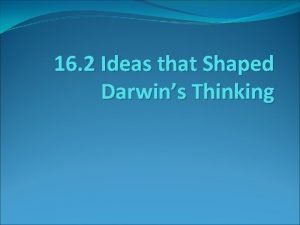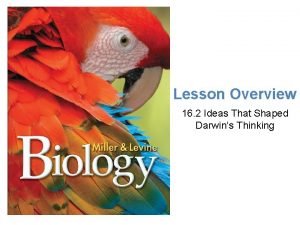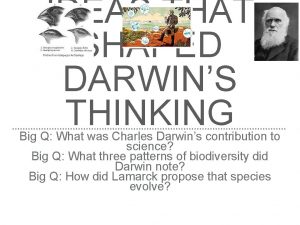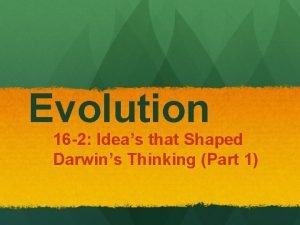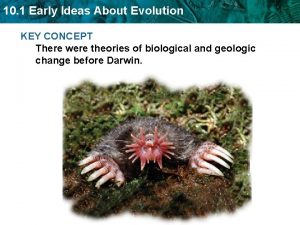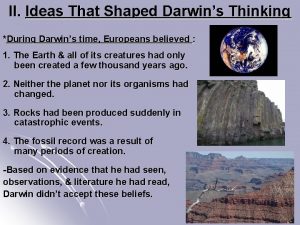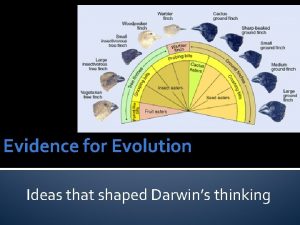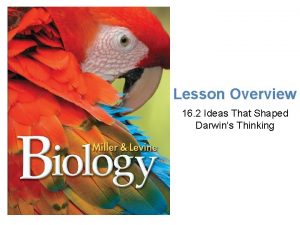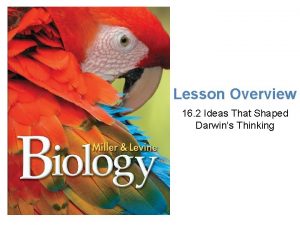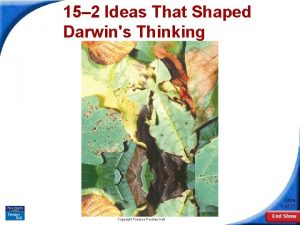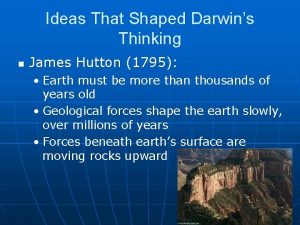Ideas that shaped Darwins Thinking EARLY EVOLUTION IDEAS













- Slides: 13

Ideas that shaped Darwin’s Thinking EARLY EVOLUTION IDEAS

Think about it… All scientists are influenced by the work of other scientists, and Darwin was no exception. The Beagle’s voyage came during one of the most exciting periods in the history of science. Geologists were studying the structure and history of Earth and making observations about the forces that shaped the Earth.

An Ancient, Changing Earth pg. 454 of your book Many Europeans in Darwin’s day believed Earth was only a few thousand years old, and it hadn’t changed much. By Darwin’s time, new science of geology was providing evidence to support different ideas about Earth’s history.

I also love Ms. Taino’s class! Hi, I’m the Founder of Modern Geology - James Hutton “Science of Geology” 1753 - became interested in studying the surface of the earth. I devoted my scientific knowledge , powers of observation, and philosophical mind to ‘geology’. “Science of Geology” The Earth is continually being formed. “Geological Change” Certain kinds of rocks are formed from molten lava. Forming connections of processes and geological features, like mountains, valleys, and layers of rock! “Geological Change” Some rocks form very slowly as sediments (naturally occurring material that is broken down by processes of weathering and erosion)build up and are squeezed into layers.

More Hutton conclusions pg. 455 of your book Forces beneath Earth’s surface can push rock layers upward, tilting, or twisting them in the process. Forces can build mountain ranges. Can be worn down by rain, wind, heat, and cold. Planet must be much older than a few thousand years. “DEEP TIME” – idea that our planet’s history stretches back over a period of time so far that a human mind can’t imagine.

She taught me to understand science, not memorize! Hi, I’m the author of “Principles of Geology” I argued that laws of nature are constant over time and scientists must explain past events in terms of processes they can see happening NOW! - Charles Lyell “Uniformitarianism” assumption is that the same natural laws and processes that operate in the universe now, have always operated in the universe in the past and apply everywhere in the universe. Thinking “Uniformitarianism” Ancient volcanoes released lava and gases, just as they do now. Ancient rivers slowly dug channels and carved canyons in the past, just as they do now.

Lyell continued… Darwin read Lyell’s books during the voyage of the Beagle and helped him appreciate the significance of an earthquake he witnessed in South America. The quake was so strong it threw Darwin onto the ground. It also lifted a stretch of rocky shoreline more than 3 meters out of the sea---with mussels and other sea animals clinging to it. He later observed fossils of marine animals in mountains 1, 000’s of feet above sea level. Darwin realized he had seen that Lyell was correct!

Key Question pg. 454 What did Hutton and Lyell conclude about Earth’s history? Earth is extremely old Methods that changed Earth in the past are the same processes that operate NOW.

I may be wrong, but I helped out Darwin in the end. “Acquired characteristics” Organisms can change the size and shape of their organs by using their bodies in new ways. Hi, I’m from France and I proposed two hypotheses. Ex. Waterbirds- could have acquired long legs because it began to move in deeper water looking for food. As the bird tried to stay above the surface, its legs would grow a little longer. - Jean-Baptiste Lamarck “Inheritance of acquired characteristics” A bird that acquired a trait, like longer legs, during its lifetime could pass that trait to its offspring. Evolving species

Evaluating his hypotheses Incorrect in several ways: Organisms do not have a drive to become more perfect—evolution does not mean that over time a species becomes “better”. There is a link between an organism’s environment and its body structures. He may have been wrong, but it paved a direction for Darwin later.

Not enough resources may lead to war, famine, and diseases. Why is it so crowded! - Thomas Malthus “Population Growth” If the human population grew unchecked, it would run out of living space and food. “Population Growth” The forces that work against population growth, include: war, famine, and disease.

Darwin’s realizations A maple tree can produce 1, 000’s of seeds each summer. One oyster can produce millions of eggs each year. If all of them survived for several generations, they would overrun the world---BUT, they don’t! Most offspring die before maturity, and only few survive to reproduce. Darwin was convinced that species evolved, but didn’t know which individuals. . and why.

Artificial Selection Nature provides the variations, and humans select those they find useful. Farmers would select for breeding only trees that produced the largest fruit or cows that produced the most milk. The selective breeding would produce more trees with even bigger fruit and cows that gave even more milk.
 Section 15-2 ideas that shaped darwins thinking
Section 15-2 ideas that shaped darwins thinking Section 15-2 ideas that shaped darwin's thinking
Section 15-2 ideas that shaped darwin's thinking Ideas that shaped darwins thinking
Ideas that shaped darwins thinking Section 15-2 ideas that shaped answer key
Section 15-2 ideas that shaped answer key Chapter 17 darwin's theory of evolution
Chapter 17 darwin's theory of evolution 16.2 ideas that shaped darwin's thinking
16.2 ideas that shaped darwin's thinking Identify early ideas about evolution
Identify early ideas about evolution Phân độ lown
Phân độ lown Block xoang nhĩ độ 2 type 1
Block xoang nhĩ độ 2 type 1 Thể thơ truyền thống
Thể thơ truyền thống Thơ thất ngôn tứ tuyệt đường luật
Thơ thất ngôn tứ tuyệt đường luật Chiến lược kinh doanh quốc tế của walmart
Chiến lược kinh doanh quốc tế của walmart Tìm vết của đường thẳng
Tìm vết của đường thẳng Hãy nói thật ít để làm được nhiều
Hãy nói thật ít để làm được nhiều

